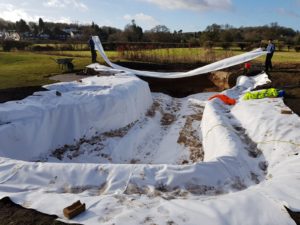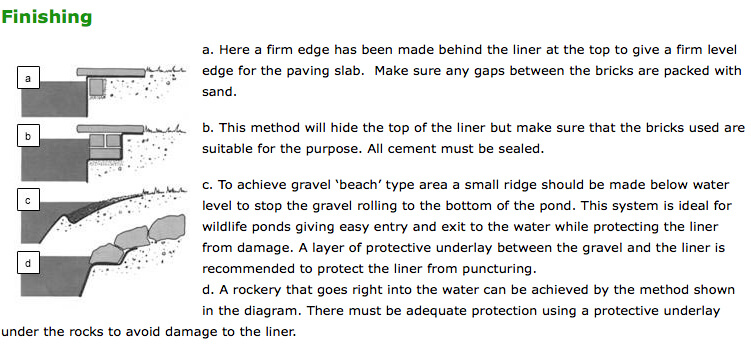It is well documented that a garden pond will add an element of peace and tranquility to any outdoor space. Whether a wildlife pond or one that is home to fish, they are also a source of water that will attract an abundance of creatures without much effort.
We have been called to rescue garden ponds loosing water so we do strongly suggest the use of an underlay and pond liner for all pond builds. Flexible pond liners such as Epalyn and Butyl are the most commonly used, as they will adapt to any size and shape. PVC pond liners are relatively cheap, but they deteriorate when exposed to sunlight, puncture more readily and are short-lived. Butyl and Epalyn rubber are more expensive, but durable and will last 30-50 years.
In this article we offer advice on how to line and edge a wildlife garden pond with a rubber pond liner while still being able to maintain an informal look. The role of a pond liner is to prevent the lose of water while also helping to maintain a healthy pond ecosystem.
Designing your wildlife pond
- Make your pond as big as possible to create many and varied habitats. The Wildlife Trust suggests a pond 1m wide by 2m long to be an ideal size.
- The deepest part should be at least 0.5 to 0.8 meters. A pond that is too shallow will heat-up too quickly in summer with the risk of turning green and ice over in winter starving your pond of oxygen.
- Ensure some edges are shallow and sloping to allow amphibians and small creatures easy access and exit.
- Include planting shelves. Place boulders intermittently between baskets planted up with plants, merging with the rim of the pond for a natural progression from land into water while also secure the pond liner in place. Aquatic plants provide much needed shelter and protection from predators. This creative mix of plant and boulders meeting with the edge of the pond also hides the visibility of the pond liner.
- Add native plants from other garden ponds or garden centres. Never take plants from the wild. March is a great time to construct a pond and add plants giving them all season to establish themselves.
- Include a rim or lip around your pond particularly if you intend using turf for the edging. The lip is there to prevent water and soil from draining from the cut turf into the pond bringing with it unwanted nutrients.

This photo is a of a very big and deep pond in construction. I have shared it as an example of a lip or rim to the edge of a pond and to show the underlay overlay on top of which the pond liner is installed and then edging material or turf is placed to keep both in place.

Pond liner installation
- Remove as many stones, roots and sharp debris from the bottom of the pond to avoid puncturing the pond liner
- First install a protective underlay to protect pond liner from puncturing
- A rubber pond liner such as Butyl or Epalyn is durable, resistant to adverse weather conditions and UV rays. They are both flexible and readily mould into the contours of a pond therefore our preferred choice
- For the beached area of a wildlife pond we also recommend adding an underlay above the pond liner for added protection when adding sand and gravel. The underlay will also help to stop the material used to create the sloping area from sliding into the deepest area of the pond.
Add a turf, boulders or stone slabs to edge a pond
With wildlife ponds there is a variety of methods used in the edging. In many cases all options are used – buried edge, boulders, stone slabs, turf, planted or gravel edges are all used. A buried edge is when the lip of the pond liner is buried in the sand. The only possible negative feature of this type of edging is that when the water level drops the liner is exposed and takes away the ‘natural-look’ of a wildlife pond so it isn’t one of our favoured choices.
When measuring up your pond liner include an extra 10% for the overlay to secure it in place. You can add the underlay both underneath and on top of the pond liner to help the sand or gravel to stick to it in a gradually sloping shallow beached area of a pond. Or, you can glue the boulders to the pond liner with a waterproof sealant. Then lay sod around the pond.
Edging a pond with paving slabs or boulders is a lot easier than using turf, however turf does offer a far more natural transition from land to water. Unlike stone, turf won’t get hot to the touch so is far kinder to small creatures when visiting your pond. If you prefer to edge your wildlife pond with turf, we recommend growing your own to avoid pesticides leaching into your pond.
Use play sand or well washed gravel to create the beached sloping edge into your pond.
Turf growing close to a pond will maintain relatively damp conditions for frogs to hide in move they move from pond to dry land. Turf will need to be maintained by hand to avoid the chance of grass clippings ending up in the water when mowing
Old logs offer a great form of cover and protection to wildlife so add a few around your pond. Add water snails to keep your pond water relatively clean.
When you have finished building your pond insects, amphibians and invertebrates will find your pond surprisingly quickly on their own.
Pond liners are an easy way of containing water for wildlife ponds particularly where the ground is porous. The pond liner does not need to detract from the natural look of your pond. Cover it with smooth surfaced pebbles. Don’t skimp on lining your pond – a high quality material will last for years with a reduced chance of puncturing. Any repair work will upset a well balanced pond with an established ecosystem. Rubber pond liners such as Epalyn (EPDM) or Butyl are non-toxic to wildlife and don’t leach chemicals into the water. These pond liners are durable, flexible and resistant to UV rays so will stand up to sunny conditions and the presence of wildlife for more than 30 years.





